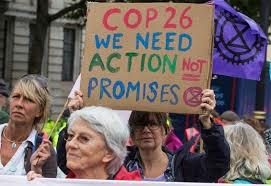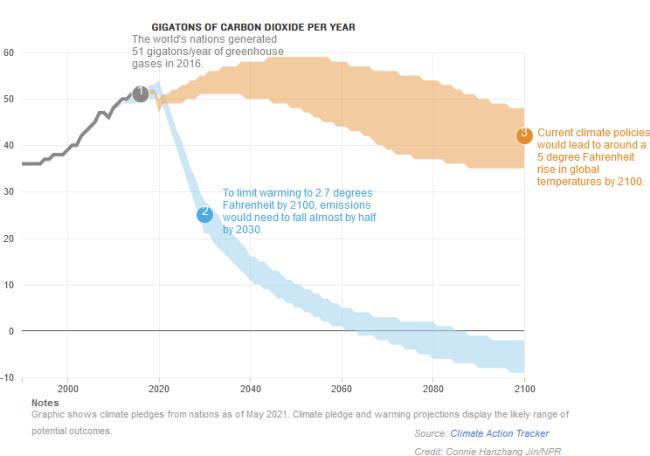 The 26th Conference of the Parties (COP) representing signatories to the United Nations Framework Convention on Climate Change is winding down in Scotland. The event was attended by 20,000 participants, including politicians, scientists, environmental activists, media representatives and business executives. Major world leaders attended promoting their national commitments to reducing the effects of global warming. COP 26 required signatories to the 2015 Paris Agreement to report on progress. It is significant that neither Jair Bolsanaro, President of Brazil nor Vladimir Putin President of Russia attended in person or remotely although their lower-ranked diplomats and negotiators participated in meetings. The U.S. was in a difficult position since the previous Administration withdrew from the Paris Agreement and the President has yet to have his far-reaching climate agenda enacted.
The 26th Conference of the Parties (COP) representing signatories to the United Nations Framework Convention on Climate Change is winding down in Scotland. The event was attended by 20,000 participants, including politicians, scientists, environmental activists, media representatives and business executives. Major world leaders attended promoting their national commitments to reducing the effects of global warming. COP 26 required signatories to the 2015 Paris Agreement to report on progress. It is significant that neither Jair Bolsanaro, President of Brazil nor Vladimir Putin President of Russia attended in person or remotely although their lower-ranked diplomats and negotiators participated in meetings. The U.S. was in a difficult position since the previous Administration withdrew from the Paris Agreement and the President has yet to have his far-reaching climate agenda enacted.
The major topics that met with universal acceptance included:-

- Recognition that it is necessary to restrict an increase in average global temperature to not more than 1.5 C (2.7 F) above pre-industrial levels. Many climate models suggest that without drastic action, this goal will not be met by 2050 and that present manifestations of global warming including floods and hurricanes that have increased in intensity will become more frequent and more devastating.
- Methane, a relatively short-lived but powerful greenhouse gas was a focus of concern with nations committing to reduce the presence of the compound. The oil industry is a major contributor to methane release. Corrective measures will include capping disused wells and methane capture in operating facilities. Nations are also committed to addressing agricultural release from ruminants and from landfills. It is estimated that reducing methane emission by half could represent a reduction of between 0.2 to 0.3 C from the predicted global rise in temperature.
- Coal-fired power generation is recognized as a major contributor to carbon dioxide release. India and China are heavily committed to burning coal with Asia producing 16.5 gigatons, or half the world’s total. Despite pledges by China and more specific action taken by Japan and South Korea, the prospects of achieving a meaningful reduction in greenhouse gas emissions in China are remote. China currently is responsible for close to 13 gigatons annually, India 3 gigatons tons, Russia 2 gigatons tons and Indonesia 1 gigaton. India has no specific goals for reduction compared to China that intends reducing greenhouse gas emissions to zero by 2060.
- The forests of the world are effectively the World’s lungs, absorbing carbon dioxide and releasing oxygen. Brazil is replacing swaths of the Amazon rainforest with soybeans and cattle and Malaysia is replacing hardwood forests to produce palm oil. Deforestation is rampant in west and central equatorial Africa to permit subsistence farming and logging.
- It is considered essential that governments become involved in reducing carbon emissions through tax incentives and effective programs of environmental remediation. Investors are currently scrutinizing projects that involve burning coal and it is anticipated that vast sums of investment capital will be used to leverage industries that will become beneficial to preservation of the environment.
- COP 26 reviewed progresses in replacing fossil fuels using solar and wind as sources of power. Success stories include Hawaii that previously was dependent on oil for 90 percent of power generation now derives a high proportion from these sources. China is the World leader in wind generation at 220 Gigawatts followed by the U.S. with 97 Gigawatts. It is estimated that a 40-acre solar array can generate 5 Megawatts; this implies that over 10 million acres in the U.S. would be required by 2050 to replace existing coal-fired generation.
- Dedicating extensive acreage to solar generation can be achieved in deserts where land is plentiful and otherwise unproductive. This will require extending grids to distribute energy. In other areas, it will be necessary to cultivate crops and to use small ruminant livestock to optimize the use of land displaced from conventional farming. Agrivoltaics is emerging as a farming practice using sheep to graze among solar arrays and cultivating suitable crops that are compatible with operation of solar ‘farms’.
- Sequestering carbon in soil will be achieved through more extensive use of cover crops and applying no-till cultivation. The proposed climate provisions in the Build Back Better initiative proposed by the Administration, currently languishing in Congress, includes financial incentives for farmers to contribute to environmental remediation.
- It is clear from deliberations at COP 26 that industrialized nations are now serious about climate change but are recognizing the costs of adopting climate-friendly initiatives in addition to supporting less-developed nations to abandon coal.
- ‘Buck Rogers’ programs including solar geo-engineering are way in the future. The possibility of removing carbon dioxide from the atmosphere is technically feasible with pilot plants currently in operation. Direct air capture would be required concurrently with programs to reduce anthropogenic carbon dioxide emission even if the world achieves a reduction of 2.9 trillion tons, considered necessary to maintain global warming at or below 1.5 C compared to the pre-industrial age.
For those that deny global warming, scientific data punctures the bubbles of self-delusion and overt denial. The carbon dioxide content of the atmosphere remained between 275 ppm and 285 ppm for millennia before the industrial age. During the 1910’s the level reached 300 ppm and by 2020 the concentration had increased to 412 ppm. From the mid 19th century onwards, average world surface temperature has increased by between 1.1 C and 1.2 C. The area of multiyear ice on the Arctic Ocean is 90 percent lower and sea level is rising worldwide by 0.4 inches every three years. Since the mid-20th Century we have been running a climatic amber light, just getting through and ignoring the consequences. Now the light is red and we have to face the consequences of global warming and climatic disruption. Effectively COP 26 renewed the commitments of the 2015 Paris Agreement and has signaled the end of our dependency on fossil-fuels to maintain our accustomed way of life. We owe succeeding generations clean air, available water and a livable planet, since it is the only one we can bequeath.
